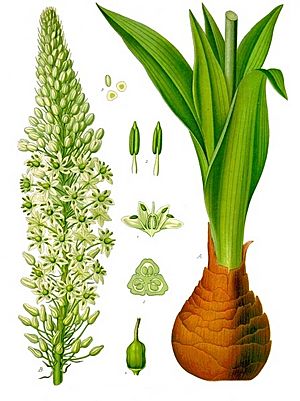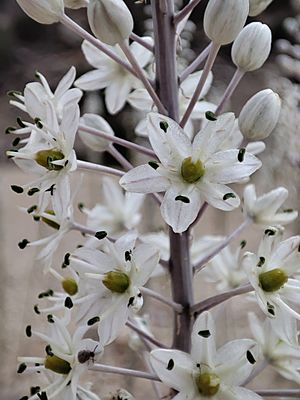Drimia maritima facts for kids
Quick facts for kids Drimia maritima |
|
|---|---|
 |
|
| Scientific classification | |
| Synonyms | |
|
Drimia maritima (also known as Urginea maritima) is a cool flowering plant. People call it by many names like squill, sea squill, or sea onion. Sometimes, it's called red squill if its flowers have a reddish tint instead of white. This plant naturally grows in southern Europe, western Asia, and northern Africa. It's part of the Asparagaceae family, which includes asparagus!
Contents
About the Sea Squill
This plant grows from a really big bulb, like a giant onion! It can be up to 20 cm wide and weigh 1 kg. Several bulbs might grow together, usually just under the soil.
In spring, each bulb grows about ten long leaves. These leaves can be up to a meter long. They are dark green and feel leathery. By fall, the leaves die away. Then, the bulb sends up a tall, thin stalk of flowers. This flower stalk can reach 1.5 to 2 meters high!
Each flower is about 1.5 cm wide. It has six petal-like parts, each with a dark stripe down the middle. Most flowers are white, but some forms have reddish flowers. The plant later produces a small fruit that looks like a capsule, about 1.2 cm long.
Where It Lives
This plant often grows in rocky areas near the coast. It is very common around the Mediterranean Basin. But you can find it in many other places too, except for the driest deserts. It can grow in sunny spots or in very shady areas.
The sea squill has a clever way of growing. It produces leaves in the spring and flowers in the fall. This is a special adaptation to the Mediterranean climate. In these areas, summers are hot and dry. Growing leaves in spring helps the plant use the cooler, wetter weather.
This plant gets pollinated in two ways: by insects and by wind. Insects like the western honey bee, the Oriental hornet, and a type of paper wasp help pollinate its flowers.
Uses of Sea Squill
The sea squill has been used for a long time, both as a medicine and for pest control. It contains special natural chemicals called cardiac glycosides. These chemicals are found in all parts of the plant. The dried leaves, however, lose their strong chemicals and can be eaten by cattle and sheep.
In some parts of Palestine, farmers use the plant to mark the edges of their land. This is because the sea squill is easy to spot and grows in distinct clumps.
Medicine from the Past
People have used this plant as a medicinal plant since ancient times. It is even mentioned in the Ebers Papyrus. This is one of the oldest medical texts from ancient Egypt, written in the 16th century BC.
Pythagoras wrote about it in the 6th century BC. Hippocrates used it to help with problems like jaundice and asthma. Its main use was to treat edema, which was called dropsy back then. This is because the plant's chemicals can help the body get rid of extra water. A mix of sea squill and vinegar was a common remedy for many centuries. The plant was also used to help with digestion and to clear mucus from the lungs.
Pest Control
The sea squill has also been used to control pests. It tastes very bitter, so most animals avoid eating it. However, rats will eat it. The plant contains a chemical that is toxic to rats. This has made the sea squill a popular way to control rats for a very long time.
The bulbs are dried and cut into small pieces. These pieces can then be ground into a powder and mixed with rat bait. In the 20th century, people even grew the plant on farms to make stronger versions for rat poison. This became more important as rats started to become resistant to other types of poisons.
Scientists have also tested sea squill as a way to control insect pests. For example, it has been tested against the red flour beetle.
Special Traditions
In ancient times, Pythagoras and Dioscorides would hang sea squill bulbs with sprouted leaves outside their doors in spring. They believed this would protect them from evil spirits. Today, people in Greece still gather and display the bulbs in winter. This is part of their Christmas and New Year traditions.
Pretty Flowers
The tall flower stalks of the sea squill are also used as cut flowers. They are popular in floristry for making beautiful arrangements.
Gallery
See also
 In Spanish: Cebolla albarrana para niños
In Spanish: Cebolla albarrana para niños











